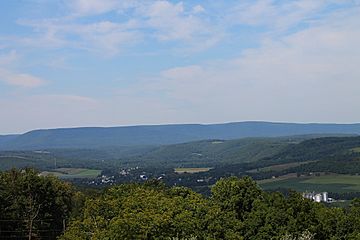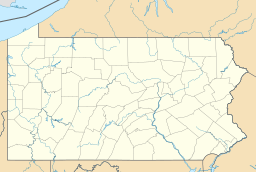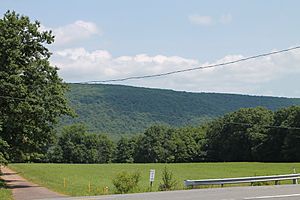North Mountain (Pennsylvania) facts for kids
Quick facts for kids North Mountain |
|
|---|---|

North Mountain (on the horizon) and northern Columbia County
|
|
| Highest point | |
| Elevation | 788 m (2,585 ft) |
| Geography | |
| Location | Davidson Township, Sullivan County, Pennsylvania, U.S.A. |
| Parent range | Allegheny Mountains |
| Climbing | |
| Easiest route | Road to fire tower |
North Mountain is a large ridge in Pennsylvania, USA. It stands about 2,584 feet (788 meters) tall. Most of the mountain is in Sullivan County. Its highest point is the tallest in Sullivan County, and one of the top 10 highest points in the whole state! Parts of North Mountain also reach into nearby Lycoming, Luzerne, and Wyoming counties.
A main road, U.S. Route 220, passes close to the mountain. Another road, Pennsylvania Route 487, actually goes right over North Mountain. Long ago, many animals like grouse, deer (even rare white deer!), and bears lived here. The mountain also has an old fire tower called the North Mountain Fire Tower. People used to work here in industries like cutting down trees (lumbering) and harvesting ice.
Contents
Exploring North Mountain: Geography and Geology
North Mountain stretches across parts of three different counties. But its very highest spot is found in Sullivan County. This mountain is part of a group called the Endless Mountains. It also sits on the eastern edge of the Allegheny Mountains.
In the past, a book from 1920 described North Mountain as the "monarch of hills." It even said the mountain looked a bit like the famous Notre Dame cathedral! The Loyalsock Valley is very close to North Mountain. The mountain covers a large area, about 250 square miles (647 square kilometers). Its average height is around 2,000 feet (610 meters).
A part of North Mountain in Davidson Township has a flat, high area called a plateau. This plateau is on the south side of Lopez Creek. About one-third of North Mountain is known as Dutch Mountain.
The main type of rock under the top of North Mountain is called the Pocono Formation. When the first settlers arrived in Davidson Township, they found rich, fertile soil at the base of the mountain. There's even a small amount of coal found on a cliff near Ganoga Lake. However, this coal layer is very thin, less than 6 inches (15 cm) thick in some places.
Waterways of North Mountain: Hydrology
North Mountain is located in the watershed of the Susquehanna River. This means that all the rain and snow that falls on the mountain eventually flows into the Susquehanna River.
Smaller streams and rivers that get their water from North Mountain include the West Branch Susquehanna River. Also, Fishing Creek and its smaller streams begin on the mountain. Muncy Creek also starts here. Some of the streams flowing from North Mountain into Fishing Creek have deep, narrow valleys called gorges.
North Mountain's Past: History
The land around North Mountain was originally home to the Seneca people. However, the last Native American village in this area was destroyed in 1784.
An old trail used to connect the area near Fishing Creek and North Mountain to forts along the Susquehanna River. This trail started in a community called Buckhorn. The first person to settle in the Sullivan County part of North Mountain was Griffith Phillips, who arrived in 1812.
A road called the Northumberland Road was built by settlers between 1806 and 1808. It likely went from North Mountain into Columbia County.
During the American Civil War, there were rumors that a secret fort with cannons had been built on North Mountain. People said that soldiers who had left the army were hiding there. In August 1864, about 1,000 Union soldiers searched the mountain for this fort, but they couldn't find it. However, in 2007, a small cabin (about 20 feet long) that was used by people hiding during the Civil War was discovered on North Mountain. Locals at the time believed that a small group of 100 men in a mountain fort could defeat a much larger army of 1,000!
Working on the Mountain: Industries
Between 1890 and 1910, North Mountain was a very busy place for lumbering, which means cutting down trees for wood. It was the last big lumbering area in this region. Many towns nearby, like Alderston, Harvey's Lake, Stull, Lopez, Jamison City, and Ricketts, were mainly lumbering towns during this time. For example, the Lehigh Valley Railroad bought 13,000 acres of forest on the mountain in 1876.
Another important industry around North Mountain was ice cutting. This involved cutting large blocks of ice from frozen lakes and ponds. This work was mostly done in the community of Mountain Springs from 1891 to 1948. It also happened near Ganoga Lake between 1896 and 1915.
Arthur Lewis Stull was a key person in both the lumbering and ice cutting businesses on the mountain. In the late 1880s, R. Bruce Ricketts owned parts of the forests on North Mountain.
There were no railroads in the North Mountain area until 1893. That's when a train line opened between Wilkes-Barre and Towanda, passing by the mountain. Later, many smaller train lines were built into the forests on North Mountain to help carry the cut timber.
Fun on the Mountain: Recreation
In the 1880s, people from big cities like Philadelphia often came to North Mountain to hunt game. They especially looked for grouse and bears. However, too much hunting caused the number of animals to drop a lot. At that time, North Mountain was one of the best places to hunt in Pennsylvania.
In 1893, R. Bruce Ricketts finished building a special retreat on North Mountain. Work on this retreat started in 1889. The North Mountain Fishing Club was also started in 1879 and continued until 1903, then started up again in 1907. R. Bruce Ricketts once lived in a large stone house called the Ganoga House near the mountain. When he lived there, it was the highest place where people lived in Pennsylvania!
North Mountain does not have any major ski resorts today. Much of the land on the mountain is part of the Pennsylvania State Game Lands, which are areas set aside for wildlife and public recreation. However, there was a ski slope on North Mountain near Sonestown between 1964 and 1984. It had a special lift to take skiers up the hill. There were plans to make the ski slope even taller, but these plans didn't work out because of local rules. As of 2008, the old ski slope was still kept in good condition.
Animals and Plants of North Mountain: Fauna and Flora
A report from 1930 mentioned that North Mountain was home to pine mice, Hoy's shrews, southern flying squirrels, and three types of bats. The report also said that pikas (which are like small rabbits) from the Rocky Mountains could live well on North Mountain.
Wolves were common in the North Mountain area in 1861. These were usually large gray wolves. But by 1865, they had become very rare. As of 1920, the mountain was one of the few places in Pennsylvania where pine martens lived, though they were common before 1900. North Mountain was also one of the last places where many northern white-tailed deer survived. More white deer have been found here than anywhere else in Pennsylvania. In the early 1800s, people said that North Mountain was home to every type of mammal and bird found in Pennsylvania. People even started studying the birds on the mountain as early as 1891.
In 1920, there were many beech trees on North Mountain. Pine and hemlock trees have also been seen there. Originally, the mountain had very old and large forests. But after the lumbering industry, these old forests were mostly replaced by new hardwood trees. These include trees like sugar maple, red maple, American beech, and black cherry.



